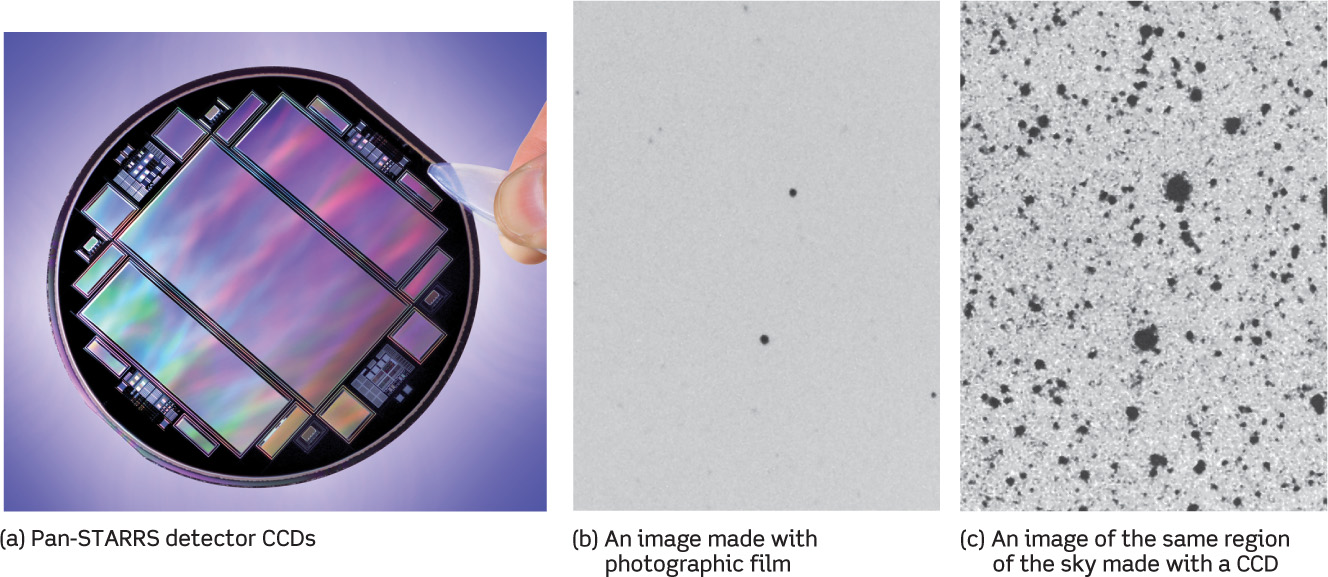6-4 A charge-coupled device is commonly used to record the image at a telescope’s focus
 Telescopes provide astronomers with detailed pictures of distant objects. The process of recording these pictures is called imaging.
Telescopes provide astronomers with detailed pictures of distant objects. The process of recording these pictures is called imaging.
Astronomical imaging really began in the nineteenth century with the invention of photography. It was soon realized that this new invention was a boon to astronomy. By mounting a camera at the focus of a telescope, long exposures can gather light from an object for an entire evening. Such long exposures can reveal details in galaxies, star clusters, and nebulae that would not be visible to an astronomer by simply looking through a telescope. Indeed, most large, modern telescopes do not have eyepieces at all.
The same technology that makes digital cameras possible has revolutionized astronomy
Originally, cameras and telescopes used photographic film, but film has now been replaced by electronic detectors. Photographic film is not a very efficient light detector, with only 2% of the photons that strike photographic film actually triggering the chemical reaction needed to produce an image. And, of course, to analyze images on a computer we need them in some electronic form. For much greater efficiency, and to capture images digitally, we use charge-coupled devices (CCDs).
Charge-Coupled Devices
The most sensitive light detector currently available to astronomers is the charge-coupled device (CCD). At the heart of a CCD is a semiconductor wafer divided into an array of small, light-sensitive squares called picture elements or, more commonly, pixels. A personal digital camera uses a single CCD chip and might have around 10 million pixels. A large astronomical camera combines many CCDs to capture a wide field of view at high resolution (Figure 6-19a). For example, the square highlighted in Figure 6-19a contains 64 CCDs; the full detector combines 60 of these squares for about 1.4 billion pixels.

Charge-Coupled Devices (CCDs) (a) These CCDs are part of the Pan-STARRS detector developed at MIT's Lincoln Laboratory. The highlighted square contains 23 million pixels from 64 individual CCDs. The full detector is made from 60 of the 5 cm wide squares, has about 1.4 billion pixels, and is nearly 40 cm wide. (b) This negative print (black stars and white sky) shows a portion of the sky as imaged with a 4-meter telescope and photographic film. (c) This negative image of the same region of the sky was made with the same telescope, but with the photographic film replaced by a CCD. Many more stars and galaxies are visible.
When an image from a telescope is focused on the CCD, an electric charge builds up in each pixel in proportion to the number of photons falling on that pixel. When the exposure is finished, the amount of charge on each pixel is read by a computer, where the resulting image can be analyzed and stored in digital form. Compared with photographic film, CCDs are some 35 times more sensitive to light, can record much finer details, and respond more uniformly to light of different colors. Figure 6-19b and Figure 6-19c show the dramatic difference between photographic and CCD images. The great sensitivity of CCDs also makes them useful for photometry, which measures the brightness of a star or other astronomical object.
In the modern world of CCD astronomy, astronomers no longer need to spend the night in the unheated dome of a telescope. Instead, they operate the telescope electronically from a separate control room, where the electronic CCD images can be viewed on a computer monitor. By viewing the CCD’s electronic image during the evening’s observations, an astronomer gets immediate feedback and often makes changes to get the best results. The control room need not even be adjacent to the telescope. Although the Keck I and II telescopes (see Figure 6-16) are at an altitude of 4100 m (13,500 feet), astronomers can now make observations from a facility elsewhere on the island of Hawaii that is much closer to sea level. This saves the laborious drive to the summit of Mauna Kea and eliminates the need for astronomers to acclimate to the high altitude.
Most of the images that you will see in this book were made with CCDs. Because of their extraordinary sensitivity and their ability to be used in conjunction with computers, CCDs have attained a role of central importance in astronomy.
CONCEPT CHECK 6-7
Why can CCDs more efficiently observe faint stars than photographic film or photographic plates?
Photographic film only captures 2% of the light it receives. For a faint star, there might be very little light captured by the film. CCDs, on the other hand, are 35 times more sensitive, capturing 35 × 2% = 70% of the light they receive.